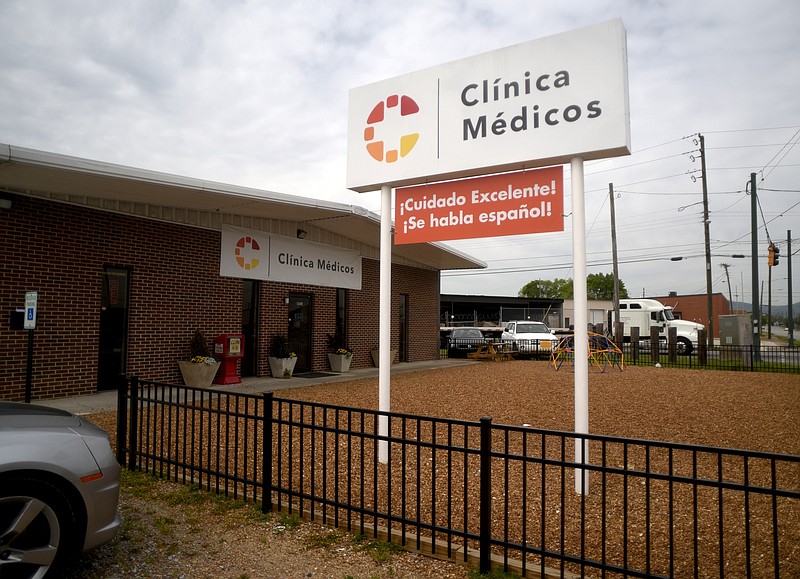Doctors and first responders don't ask for immigration papers when treating patients with the COVID-19 virus, but Chattanooga became the latest U.S. city Thursday to record a rise in cases among a Hispanic immigrant population.
Hispanics represent about 6% of Hamilton County's population, according to the U.S. Census Bureau, but now represent more than 40% of all current confirmed cases of the virus in the county. More than 50% of noncitizens in Hamilton County, according to the 2018 Census American Community Survey, are natives of Latin America.
Other U.S. states and cities are experiencing a similar rise.
Hispanics make up 39% of the population in California but represent 49% of the state's virus cases. In Travis County, Texas, 33.9% of the population is Hispanic, but Hispanics comprised 64% of new virus hospitalizations in Austin-Travis County last week. In Baltimore, Maryland, Hispanics accounted for 38% and 36% of new virus patients in two Johns Hopkins hospitals last week.
The finding exposes the problems inherent when a family or individuals choose to come into the country, often illegally.
If immigrants are here illegally, they are ineligible for the federal Medicaid program for low-income people. However, according to the TennCare Policy Manual, emergency service providers in some cases may be reimbursed for treating them. And they are not turned away for treatment at Erlanger hospital, the city's only public hospital.
Also ineligible for many federal benefits because of their status, illegal immigrants are working to provide food and shelter for themselves or their families. That often means working in crowded spaces like meat-packing or processing plants or alongside numerous workers such as in building construction, roofing or landscaping.
If an individual becomes sick with the COVID-19 virus or if a person is asymptomatic and continues to work out of need, the virus is easily spread among co-workers, even family. That was evident with the announcement Thursday of 11 cases of the virus at the local Koch Foods chicken processing plant. Cases also have been confirmed at a local construction site and at a different poultry processing plant.
Undocumented immigrants also are less likely to have internet access, so they frequently miss out on critical information about the potential devastation of the virus, how it spreads and guidance on safety measures all residents should be taking.
These individuals often are wary of anyone official, fearing they might be Immigration and Customs Enforcement (ICE) or someone who will reveal their names to ICE. Thus, an invitation to be tested for the virus by state health officials, even at no charge, might go unheeded.
Yet, immigrant advocates blamed local officials in a Times Free Press report Friday for the increase of the virus in the Hispanic community, suggesting that they didn't pay attention to the community because of their race. Frankly, we think such a statement is indefensible.
For the past two months, local health and government officials have been trying to get a handle on the virus itself, preparing for what was feared to be a surge in infections that would overwhelm hospitals, attempting to get up to speed on community testing and figuring just how soon and how widely to close down businesses, schools and public facilities.
The COVID-19 virus has been unlike anything national, state and local officials have ever dealt with, so expecting them to know exactly what to do, exactly what populations to target and exactly how to disseminate the information is nonsensical.
In hindsight, it's easy to say that this group or that population should have been treated differently.
Remember the first huge number we were told, for example. The country's best medical minds told us up to 2.2 million Americans could die from this virus. That they haven't - and probably won't - is good news but is emblematic of how things change as more information is gleaned.
Going forward, armed with the information we're learning, we know how strict health protocols must be for those who go in and out of nursing homes. We know the poor health of many black Americans has caused them to have more cases of the virus than is the percentage of their population in the country. We know how the virus can spread more easily among workers in crowded conditions. And we know that the lack of information about the virus among Hispanic immigrants, and their fear of encounters with governmental authorities, have impeded their understanding of how dangerous COVID-19 is.
As a compassionate country, our doctors and first responders will deal with whomever is in front of them, especially where it comes to a global pandemic. That's who we are as a people. But the vulnerability of immigrant communities has made an already difficult challenge even more daunting.
